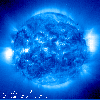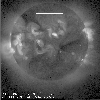



Recently, bright S's have been popular among solar physicists, especially those who study flares and CMEs. These S's are called 'sigmoids,' and they are usually observed as bright structures in soft X-rays. They are known to be a signature of highly sheared magnetic field in an active region, which thus has a high potential for energetic flares. You can find many images and articles on the Web.
However, the 'S' here is not an X-ray sigmoid but one falling into a rather traditional category: a dark filament. The one observed during last week(4th, 2001) showed a very gorgeous 'S' shape in SoHO/EIT images in the extreme ultraviolet. It can, of course, be seen in routine H-alpha image as shown below (unfortunately, it does not appear so perfectly S-shaped as the EIT version does). It was clearly located on a magnetic inversion line, which bends like an 'S' around the region in question, as also shown a image below. Observed by Yohkoh/SXT, however, it is not distinct at all.




What is interesting is that this dark 'S' erupted near the west limb and caused a flare just like an X-ray sigmoid may do.
During the week 4, 2001, the activity on the sun was not so high, although a few M-class flares were reported. Instead, several long filaments crawled quietly on the disk, and one of them strongly drew one's attention because of its beautiful S-shape. However, it was too faint in soft X-rays to be chosen as Yohkoh's observation target, which is usually set to the brightest region on the disk. It seemed to pass across the disk and go away with its stylish shape remaining. However, it was an old fox! It did erupt just before hiding away behind the limb, and Yohkoh caught its tail!
As you may see in the above movies, the evolution of the filament is identified in the HeI (low-temperature) images of SoHO, while the formation of arcades accompanying the filament eruption was mainly observed by Yohkoh/SXT because these are high-temperature structures. It appears that the filament erupted at the time before 1:18 UT, but we cannot tell exactly due to the low cadence of the EIT images. The SXT arcades started to form around 1:30 UT and became brightest around 3:00 UT.
Judging from the GOES flux variations (flares), it was a mediocre and boring week, but from a CME point of view it was highly active and exciting. Actually, this event resulted in one of the major CMEs within those few days. Have a look at the LASCO MPEG movie. The CME associated with the eruption of the dark 'S' is the one early on January 26th. This CME was accompanied only by a small peak in soft X-ray flux (C1.6, around 3:00 UT, 26-Jan). Even this was just a coincidence; the SXT images show that an entirely different region flared. The CME-related arcade appeared clearly in the X-ray images, but type of CME counterpart could hardly be termed outstanding, because of the faintness of the arcade. This event shows an example of a type of CME, for which the soft X-ray morphology, not just the X-ray brightness, should be used in a forecast.
This may be further evidence for the recent exciting work of L. Van Driel and collaborators, who are studying the "last best" region AR 9398 from 1996. They find that flare productivity and CME productivity seem to be somewhat uncoupled, and they offer the suggestion that flares may represent relaxations following energy buildup, whereas CMEs may represent relaxations following magnetic helicity buildup.
February 2, 2001